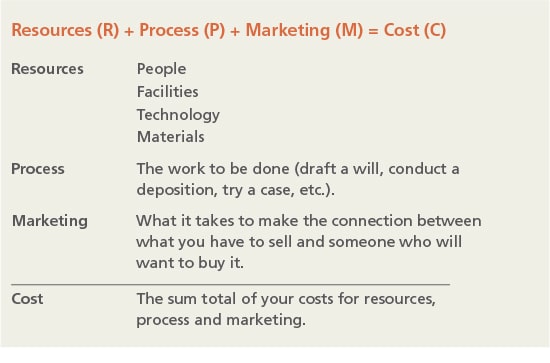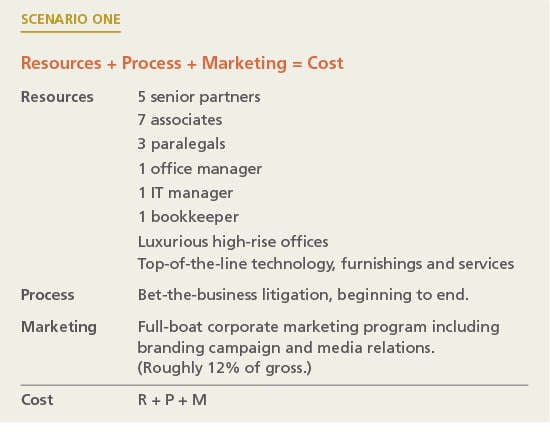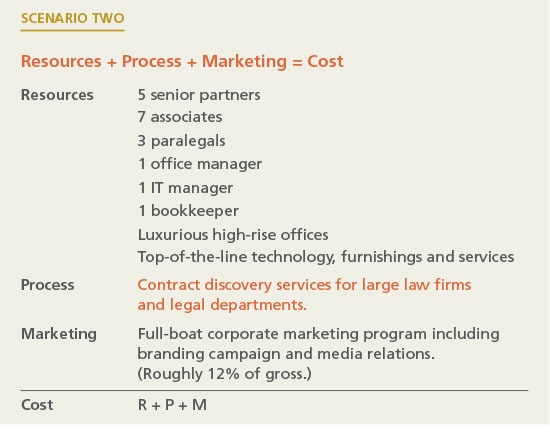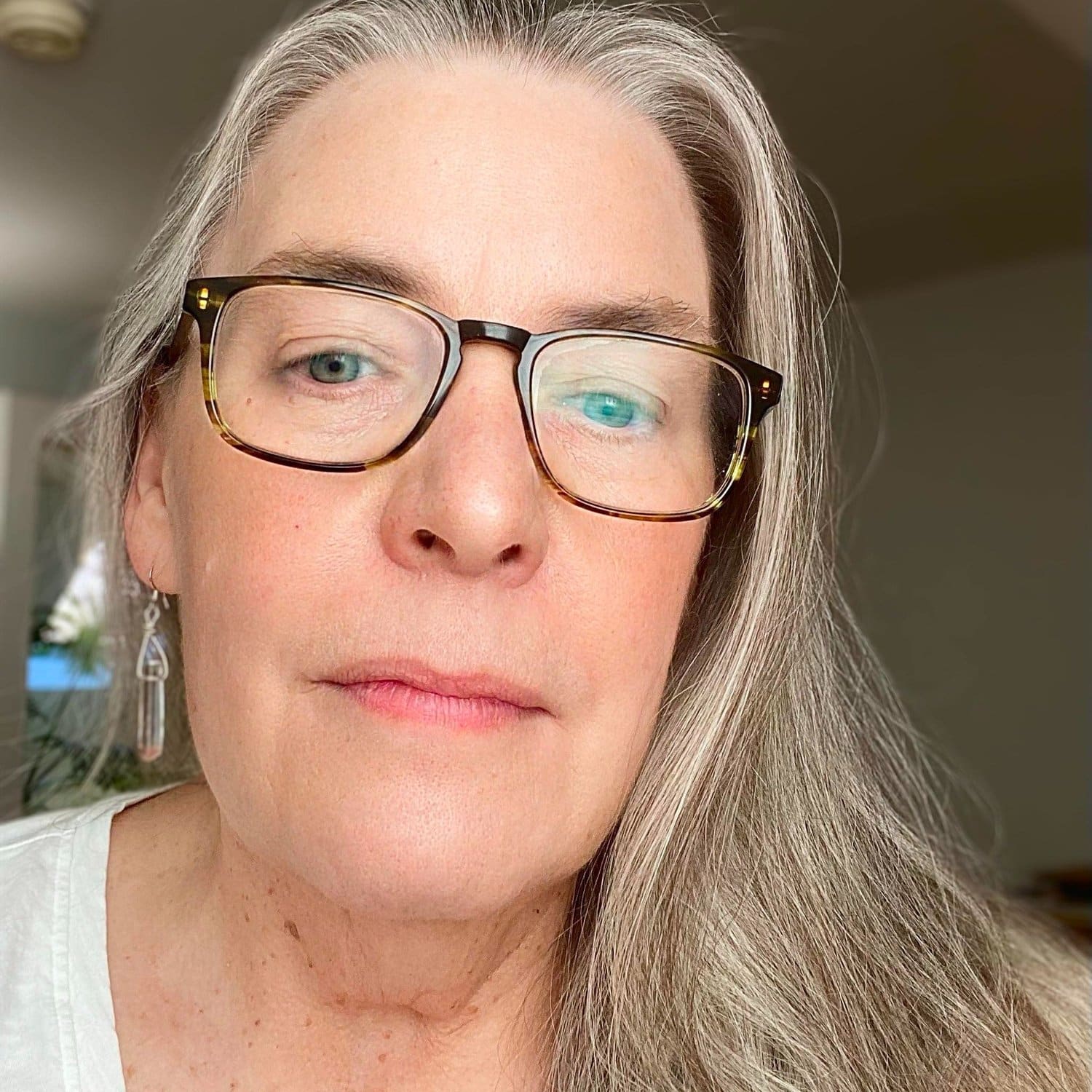It’s simple math, actually. You can fiddle around with yearly billables expectations, “pieces of the pie” and annual hourly rate adjustments — and even stop stocking free coffee in the break room. But your ability to build a legal business that thrives — one that makes money — is going to require a more systemic approach.
You’ll need to do more than “tweak” to make things work to your satisfaction in today’s environment. Let’s look at the money-making proposition that is your legal practice: R + P + M = C
Yeah, you remember this. It’s algebra! (Yawn.) But this time, you really are going to use it.
(Okay, let’s stop here and admit that this is oversimplified. But there’s a point to be made, so that’s just how it’s going to be.)
Once you’ve done the math and figured out your cost, you simply subtract that amount from what someone will pay for the service you are providing. What’s left is your profit. Boom.
Fee – Cost = Profit
Yep. Simple. But what does it tell us? Think back to Mr. McGrumpy’s third-period algebra class. What makes it algebra is that you can “perform operations of arithmetic with non-numerical mathematical objects representing numbers that are either not yet known or unspecified.” In other words, algebra helps you predict things when you don’t have all the facts. In this case, it helps show how you can build a better, or at least different, mousetrap out of your law practice.
Let’s take litigation. If the following scenario were true for your firm, you would simply drop real numbers into place instead of the letters.
Still fairly straightforward, right? Now let’s switch something. Let’s say you decide to no longer do litigation, but you have great knowledge and experience when it comes to complex discovery, including document management and depositions.
Your equation changes in part, as we see in the next scenario, below, but R + P + M still equals C.
About your costs — some are fixed, some are flexible. Depending on the culture of your firm, the number of people, their roles and the nature of your offices, then your personnel and facilities may be fixed costs (and typically the biggest ones). And this can make it extremely difficult to innovate. It helps explain why most new business models (your competition) come from outside of established firms. And why so many “new normal” lawyers first bailed out of BigLaw.
If you did this in real life, you’d notice pretty quickly that some people in your firm are no longer engaged in doing work of any particular value to the firm. Yet you continue to pay them the same amount because … well, that’s the deal. Unfortunately, you will find it hard to compete with others offering the same services with such a high cost of unneeded resources. (I’ll leave you to figure out how to handle partners who don’t have anything to do.)
Work It Out
Back to the algebra. You can take that R + P + M = C equation, turn any one of those letters into an actual known — and then work from there to make it work. For example, let’s say P is going to equal the phone calls and letters required in collections work, and that your client will pay $100 for every $1,000 of bad debt you collect.
Resources + Collecting on Bad Debt + Marketing = Cost
$100 – Cost = Your Profit
Now, all you have to do is work out how to build a business capable of collecting $1,000 at a cost of less than $100. It may be you in a home office with a smartphone and a laptop getting clients via word of mouth. Or it may be viable to staff collections work with a few paralegals, given the economies of scale and salary expectations. Or maybe there’s a way to work it out using certain types of technology. The point is, you can work it out.
You can attack this money-making proposition from various angles:
- Start with fixed resources and solve the problem with the kind of work and marketing necessary to arrive at a cost you like.
- Identify a service or product that the market requires, figure out how to staff and house it, and what it will take to get it to market with a cost that both suits you and allows for competitive pricing.
- Or start with cost if you’d like. (Just a warning that it is a much more challenging proposition to say, “I need X dollars,” and then build a model that gets you there.)
Your best bet (and my hearty recommendation) is to start with an unmet need in the marketplace and build your equation from there. After all, that’s what’s going on now in the new legal business. For example:
- Some young lawyers noticed horrible inefficiencies in the way most lawyers handled document production. They started a document production business, and now law firms contract with them, saving the client money and simplifying the work of the law firm.
- Some observed that simple contracts were often far too expensive for most small businesses and, in the absence of complexity, were something that could be easily adapted to a computer program that asks 20 questions and spits out the correct documents.
- Since corporate counsel demanded more certainty up front about their outside legal costs, some firms developed systems that allow them to provide the same high-quality services at a fixed fee. Some didn’t and they are looking for new work and new clients.
Many traditional law firm functions are being cherry-picked from the standard-issue law firm business model. What that will ultimately leave behind is something that can’t be replaced by systems, apps or machines: the wisdom, perspective and skill of lawyers who have the bet-the-business answers … who know exactly which button to push … whose presence turns a negotiation positive in a matter of minutes. That’s what will be irreplaceable. The equation for that?
R (1 amazing wise lawyer) + P (solve difficult problems quickly)
+ M (word of mouth) = Cost
Fee (whatever it takes) – Cost = Profit
Lest you automatically conclude this is the direction for you, consider one final calculation: There are nearly 1.5 million lawyers in the U.S. alone. If there’s only going to be a need for 1,000 of these super-high-performers on a good day … where does that leave you?
Merrilyn Astin Tarlton is Partner/Catalyst at Attorney at Work, a founding member of the Legal Marketing Association, a member of the LMA Hall of Fame, and a past President of the College of Law Practice Management. Follow her on Twitter @AstinTarlton.
Free Download: A New Way to Look at Your Business
Find wit and wisdom on the new legal marketplace in our e-zine “New Math, New Money: A Lawyer’s Guide to the Changing Business of Law.” As always, it’s free to anyone who subscribes to Attorney at Work!


























